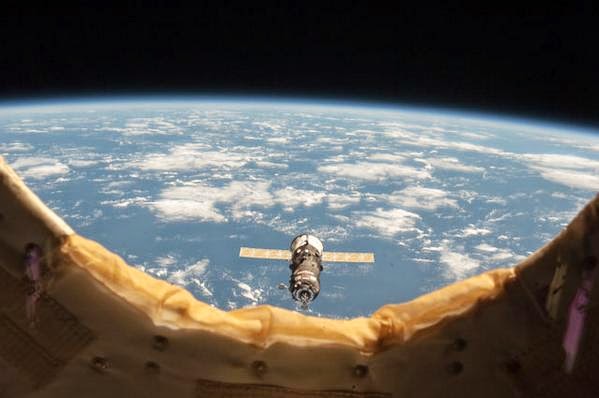Dragon cargo spacecraft attached to ISS CanadArm robotic arm. About to let go and drift free of the station before de-orbiting. Credit: SpaceX.
Tuesday's spectacular destruction of the Orbital Science Antares rocket and Cygnus spacecraft happened during a busy week of transitions at the International Space Station. The crew of Expedition 41 had seen an eventful October so far with three spacewalks. The crew has begun preparations for an eventual rearranging of the station's docking modules, readying for the time when commercial spacecraft will be arriving with regular ferry flights transferring astronauts between Earth and the station. New experiments are arriving, old ones are being returned to Earth of discarded, garbage is being removed, and supplies building up.
The Dragon spacecraft floats down via parachute to a watery recovery off the coast of Baja California. Credit: SpaceX
Currently there is a regular fleet of unmanned spacecraft that come and go at the ISS bringing supplies or removing equipment and garbage. The only one that actually returns to Earth is SpaceX's Dragon. On Saturday, the Dragon undocked from the station loaded with returning equipment and science experiments and samples, and made a safe splashdown in the Pacific Ocean for a speedy recovery.
A Russian Progress cargo ship undocks and moves away from the ISS. This one happens to be an earlier Progress 35 mission.
On Monday, while the Cygnus "Deke Slayton" spaceship waited for liftoff (which was scrubbed Monday due to an intruding boat near the launch site), The Progress 56 mission spacecraft undocked from the ISS loaded with garbage and waste. It would burn up in the atmosphere upon re-entry. The departure cleared the way for a new ship to dock at the Pirs module.
Spacecraft docked at the ISS on October 27. Cr: NASA.
After the departure of the Progress 56 craft, there remained two Soyuz crew spaceships and the European Space Agency's ATV-5 cargo ship. Recently, the ATV-5 engines were used to move the station away from a potential collision with space debris.
Then the Cygnus flight was cancelled, unexpectedly.
Pad 0A at Wallops Island, Virginia. Wreckage of the spacecraft is being examined and cleared.
It will take weeks to analyze what exactly happened to the Antares rocket. There is, of course, damage to the pad, the buildings and equipment around the pad, and to a nearby sounding rocket launcher as well.
And then it was back to business!
Soyuz rocket lifts off with the Progress 57 mission.
Early Wednesday, the Russian space agency launched a Soyuz 2-1A rocket from Baikonur in Kazakhstan. This rocket variant replaces the usual Soyuz-U, and uses new engine types. The launch was good, and the Progress M-25M spacecraft (designated Progress57 by NASA) headed into orbit on a six-hour trip to the ISS.
Progress approaches the station.
Progress slowly approaches towards the Pirs module.
Progress almost ready to dock.
Exactly six hours after launching, the Progress spacecraft docked with the ISS bringing supplies of fuel, air, water, propellant, and scientific equipment. Progress 57 will stay docked for the next 6 months. The Progress 56 spacecraft, still in orbit, will be performing ground-controlled engineering tests in orbit until commanded to de-orbit and burn up in the atmosphere.










No comments:
Post a Comment